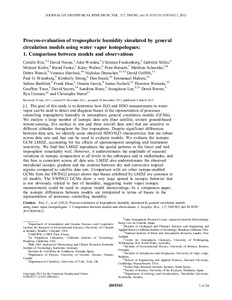Por favor, use este identificador para citar o enlazar este ítem:
http://hdl.handle.net/20.500.11765/2392
Process-evaluation of tropospheric humidity simulated by general circulation models using water vapor isotopologues: 1. Comparison between models and observations
| Título : | Process-evaluation of tropospheric humidity simulated by general circulation models using water vapor isotopologues: 1. Comparison between models and observations |
| Autor : | Risi, Camille; Noone, David; Worden, John; Frankenberg, Christian; Stiller, Gabriele P.; Kiefer, Michael; Funke, Bernd; Walker, Kaley; Bernath, Peter; Schneider, Matthias
 ; Wunch, Debra; Sherlock, Vanessa; Deutscher, Nicholas Michael; Griffith, David W. T.; Wennberg, Paul O.; Strong, Kimberly; Smale, Dan; Mahieu, Emmanuel; Barthlott, Sabine; Hase, Frank; García Rodríguez, Omaira Elena
; Wunch, Debra; Sherlock, Vanessa; Deutscher, Nicholas Michael; Griffith, David W. T.; Wennberg, Paul O.; Strong, Kimberly; Smale, Dan; Mahieu, Emmanuel; Barthlott, Sabine; Hase, Frank; García Rodríguez, Omaira Elena



|
| Palabras clave : | General circulation models; Relative humidity; Process-based evaluation; Isotopes |
| Fecha de publicación : | 2012 |
| Editor: | American Geophysical Union |
| Citación : | Journal of Geophysical Research: Atmospheres. 2012, 117(D5), p. D05303 |
| Versión del editor: | https://dx.doi.org/10.1029/2011JD016621 |
| Resumen : | The goal of this study is to determine how H2O and HDO measurements in water vapor can be used to detect and diagnose biases in the representation of processes controlling tropospheric humidity in atmospheric general circulation models (GCMs). We analyze a large number of isotopic data sets (four satellite, sixteen ground-based remote-sensing, five surface in situ and three aircraft data sets) that are sensitive to different altitudes throughout the free troposphere. Despite significant differences between data sets, we identify some observed HDO/H2O characteristics that are robust across data sets and that can be used to evaluate models. We evaluate the isotopic GCM LMDZ, accounting for the effects of spatiotemporal sampling and instrument sensitivity. We find that LMDZ reproduces the spatial patterns in the lower and mid troposphere remarkably well. However, it underestimates the amplitude of seasonal variations in isotopic composition at all levels in the subtropics and in midlatitudes, and this bias is consistent across all data sets. LMDZ also underestimates the observed meridional isotopic gradient and the contrast between dry and convective tropical regions compared to satellite data sets. Comparison with six other isotope-enabled GCMs from the SWING2 project shows that biases exhibited by LMDZ are common to all models. The SWING2 GCMs show a very large spread in isotopic behavior that is not obviously related to that of humidity, suggesting water vapor isotopic measurements could be used to expose model shortcomings. In a companion paper, the isotopic differences between models are interpreted in terms of biases in the representation of processes controlling humidity. |
| Patrocinador: | TCCON measurements at Wollongong and Darwin are supported The mid-infrared FTIR retrievals have been performed in the framework of the project MUSICA (http://www. imk-asf.kit.edu/english/musica), which is funded by the European Research Council under the European Community’s Seventh Framework Programme (FP7/2007–2013)/ERC grant agreement 256961. This work was supported by NASA Energy and Water-cycle Study (07-NEWS07-0020) and NASA Atmospheric Composition program (NNX08AR23G). We thank all reviewers for their fruitful comments. |
| URI : | http://hdl.handle.net/20.500.11765/2392 |
| ISSN : | 2169-897X 2169-8996 |
| Colecciones: | Artículos científicos 2010-2014 |
Ficheros en este ítem:
| Fichero | Descripción | Tamaño | Formato | ||
|---|---|---|---|---|---|
| Risi_2012-JGRSE.pdf | 1,59 MB | Adobe PDF |  Visualizar/Abrir |
Los ítems de Arcimis están protegidos por una Licencia Creative Commons, salvo que se indique lo contrario.





